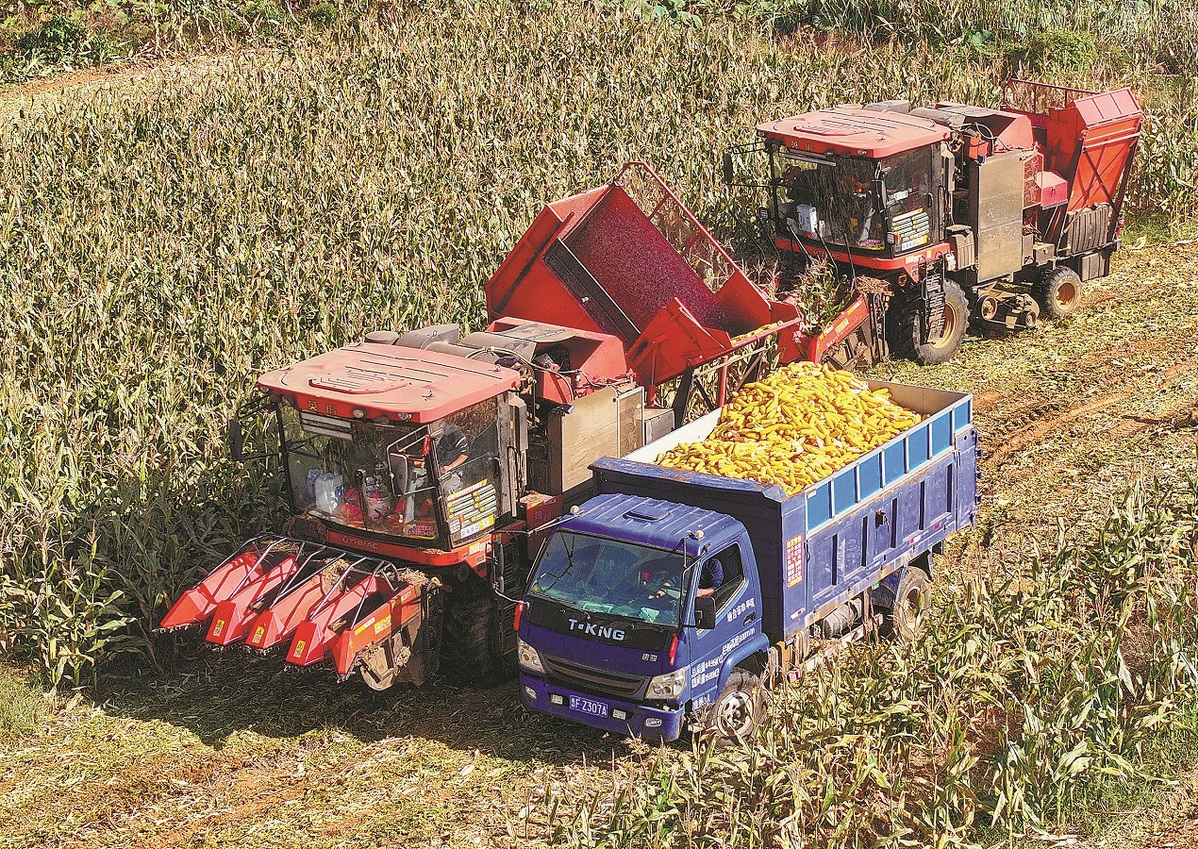Farmers weather adversity to reap record grain harvests
China's leading agricultural provinces secure bumper crops despite natural disasters






Nature wreaks havoc
Farmers overcame various disasters to achieve the grain harvest, as the country grappled with extreme weather events occurring with increasing frequency this year, featuring both relentless heat and heavy downpours.
They attribute the hard-earned bumper harvest to the combined effects of the authorities' swift response to disaster relief, the continuous development of high-standard farmland, the promotion of modern and even smart farming methods, and the timely payment of agricultural insurance.
Zhao Zhidong, a farmer in Zhecheng county in central China's Henan province, said that his 13 hectares of farmland suffered from severe drought in June. He hurried to hire more than 10 people to pump water round-the-clock into the field to rescue the corn seedlings.
In the middle of July, the same field was subjected to continuous heavy downpours, and Zhao had to hire people to do drainage work. Under the coordination work of the local authority, they dug a channel to direct the rainwater into nearby rivers.
Half of the annual precipitation occurred during just three days of extreme rainfall that month. The average precipitation in Zhecheng reached 397 mm from July 15 to 18, while the county's annual precipitation over the past 30 years averaged 767 mm, according to the county's meteorological service.
Zhao has since harvested his corn, and the field's per-unit yield is 25 percent less than that of a normal year. However, he is satisfied with the result after the difficulties encountered this year.
In addition, local authorities helped farmers rebuild irrigation and drainage infrastructure following the disasters.
The heavy rainfall resulted in crop failures in nearby Tanghe county, Henan. After the floodwaters receded, however, agricultural experts guided farmers in replanting mung beans, sweet potatoes, vegetables and other cash crops to compensate for their losses.
Qiao Zhenqun, who lost 6.7 hectares of his 133.3-hectare corn harvest this year, said the replanting was successful.
The income from mung beans and sweet potatoes is expected to be slightly higher than that from corn, based on current market prices.
Data from the Henan investigation group of the National Bureau of Statistics shows that Henan reaped a total summer grain output of 37.9 million tons, 6.64 percent higher than that of last year, safeguarding the province's role as the country's second-largest grain producer.
Although its autumn grain fields suffered losses, harvesting of 5.1 million hectares of crops will soon be completed. Henan's annual grain output is expected to remain stable at more than 65 million tons.
In central Hunan province, Zhang Shunda, a veteran grain grower in Taoyuan county, in Changde, has been busy harvesting rice grown on his 40 hectares of land. Estimating a harvest of more than 300 tons of rice, the farmer let out a sigh of relief.
It was a hard year for rice farmers in Hunan, as the province experienced a snowstorm at the beginning of the year and severe floods in summer.
"All three of my rice seedling greenhouses were toppled by the snowstorm in February, and 40 hectares of early rice was inundated by floods in June," said Zhang.
The heavy rainfall caused severe damage to early rice growth in Taoyuan, the top grain-growing county in Hunan. Local authorities promptly took measures to help farmers overcome the disaster.
Zhang said technicians dispatched by the county and township governments visited him to investigate the damage after the snowstorm and guided him on rebuilding and heating his warehouse. He received 80,000 yuan in disaster relief subsidies and more than 300,000 yuan in policy subsidies for rice planting.
According to Hunan's Provincial Department of Agriculture and Rural Affairs, grain production in the province remained sound this year. The harvesting of more than 1.5 million hectares of mid-season rice in the province has been completed, with an estimated year-on-year yield increase of about 1 percent. Harvesting is nearing completion on more than 1.3 million hectares of late rice fields, which can expect a year-on-year yield increase of 1.5 percent.














